Sthenoteuthis
Richard E. Young and Michael Vecchione


This tree diagram shows the relationships between several groups of organisms.
The root of the current tree connects the organisms featured in this tree to their containing group and the rest of the Tree of Life. The basal branching point in the tree represents the ancestor of the other groups in the tree. This ancestor diversified over time into several descendent subgroups, which are represented as internal nodes and terminal taxa to the right.

You can click on the root to travel down the Tree of Life all the way to the root of all Life, and you can click on the names of descendent subgroups to travel up the Tree of Life all the way to individual species.
For more information on ToL tree formatting, please see Interpreting the Tree or Classification. To learn more about phylogenetic trees, please visit our Phylogenetic Biology pages.
close boxIntroduction
Members of Sthenoteuthis are the dominant ommastrephid squids in tropical waters of the world's oceans and are commonly seen at the ocean's surface at night. They range in size from ca. 100 mm ML to 650 mm ML.Brief diagnosis:
An ommastrephin with ...
- Large aggregation of subcutaneous photophores forming a dorsal photophore patch on anterodorsal region of mantle.
Characteristics
- Arms
- Arms tips in subadults not unusually attenuate; arms I with 20-30 pairs of suckers.
- Hectocotylus with pores. A fully developed pore passes through the protective membrane.
- Width of ventral protective membrane of arm III approximately equal to arm width.
- Arms tips in subadults not unusually attenuate; arms I with 20-30 pairs of suckers.
- Tentacles
- Largest club suckers with small pointed teeth and one large pointed tooth in each quadrant.
 Click on an image to view larger version & data in a new window
Click on an image to view larger version & data in a new window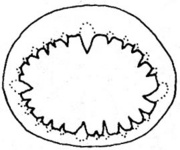
Figure. Oral view of inner ring of largest club sucker of S. oualaniensis. Drawing from Roeleveld (1988).
- Funnel/mantle locking-apparatus
- Mantle locking-apparatus with anterior bifurcation.
- Mantle locking-apparatus with anterior bifurcation.
- Photophores
- Small subcutaneous photophores on ventral surfaces of mantle, head and arms III-IV (see photographs on Ommastrephinae page).
- Large, oval, dorsal photophore patch composed of dense aggregaton of subcutaneous photophores on mantle near anterior end.
- Luminous patch on ventral surface of each eyeball.
- Two photophores on ventral surface of intestine in paralarvae and juveniles.
 Click on an image to view larger version & data in a new window
Click on an image to view larger version & data in a new window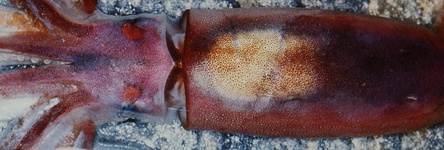

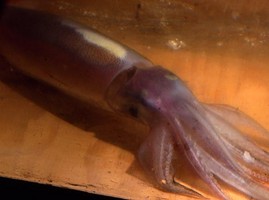
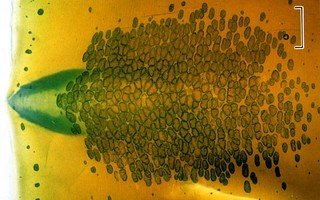
Figure. Dorsal and dorsal-oblique of the dorsal photophore patch in S. oualaniensis with various stages of concealment. Top - Photophore patch (white area) mostly visible. Middle - Photophore patch almost completely concealed by chromatophores. Typically in preserved squid, the patch is not seen due to chromatophore cover. Bottom left - Photophore patch half partially covered and half uncovered. Photographs by R. Young. Bottom right - Cleared and stained portion of the mantle showing the dorsal photophore patch and the tip of the gladius. Scale bar is 3 mm. Photograph from Kishimoto and Kohno (1992).
- Small subcutaneous photophores on ventral surfaces of mantle, head and arms III-IV (see photographs on Ommastrephinae page).
Comparison of species
| Funnel/mantle locking-apparatus fused | |
| Sthenoteuthis oualaniensis | Yes |
| Sthenoteuthis pteropus | No |
Distribution
Circumglobal in tropical and subtropical, occasionally in temperate waters. S. oualaniensis is found in Pacific and Indian Ocean waters and S. pteropus in Atlantic Ocean waters.References
Kishimoto, H. and H. Kohno. 1992. Development of the luminous organ in the purpleback flying squid, Sthenoteuthis oualaniensis, as shown by Alcian Blue stain techniques. Bull. Inst. Oceanic Res. & Develop., Tokai Univ, 13: 71-83.
Roeleveld, M. A. 1988. Generic interrelationships within the Ommastrephidae (Cephalopoda). P.277-314. In: M. R. Clarke and E. R. Trueman (eds.). The Mollusca. Vol. 12. Paleontology and Neontology of Cephalopods. Academic Press, N.Y., 355pp.
Title Illustrations

| Scientific Name | Sthenoteuthis oualaniensis |
|---|---|
| Location | 5 km off Kona, Hawaii at 19°42.2'N, 156°5'W over bottom depth of 1500m. |
| Comments | S. oualaniensis swimming just below the surface on a calm night (wind SW at 5 kts). |
| Specimen Condition | Live Specimen |
| Identified By | R. E. Young |
| View | Anterolateral |
| Copyright | © 2014 Jeffrey Milisen |
About This Page

University of Hawaii, Honolulu, HI, USA

National Museum of Natural History, Washington, D. C. , USA
Page copyright © 2017 and
 Page: Tree of Life
Sthenoteuthis .
Authored by
Richard E. Young and Michael Vecchione.
The TEXT of this page is licensed under the
Creative Commons Attribution-NonCommercial License - Version 3.0. Note that images and other media
featured on this page are each governed by their own license, and they may or may not be available
for reuse. Click on an image or a media link to access the media data window, which provides the
relevant licensing information. For the general terms and conditions of ToL material reuse and
redistribution, please see the Tree of Life Copyright
Policies.
Page: Tree of Life
Sthenoteuthis .
Authored by
Richard E. Young and Michael Vecchione.
The TEXT of this page is licensed under the
Creative Commons Attribution-NonCommercial License - Version 3.0. Note that images and other media
featured on this page are each governed by their own license, and they may or may not be available
for reuse. Click on an image or a media link to access the media data window, which provides the
relevant licensing information. For the general terms and conditions of ToL material reuse and
redistribution, please see the Tree of Life Copyright
Policies.
- First online 29 November 2009
- Content changed 11 October 2015
Citing this page:
Young, Richard E. and Michael Vecchione. 2015. Sthenoteuthis . Version 11 October 2015 (under construction). http://tolweb.org/Sthenoteuthis/19946/2015.10.11 in The Tree of Life Web Project, http://tolweb.org/




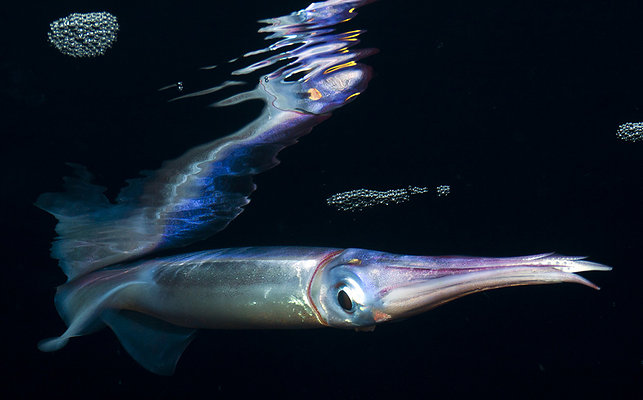


 Go to quick links
Go to quick search
Go to navigation for this section of the ToL site
Go to detailed links for the ToL site
Go to quick links
Go to quick search
Go to navigation for this section of the ToL site
Go to detailed links for the ToL site